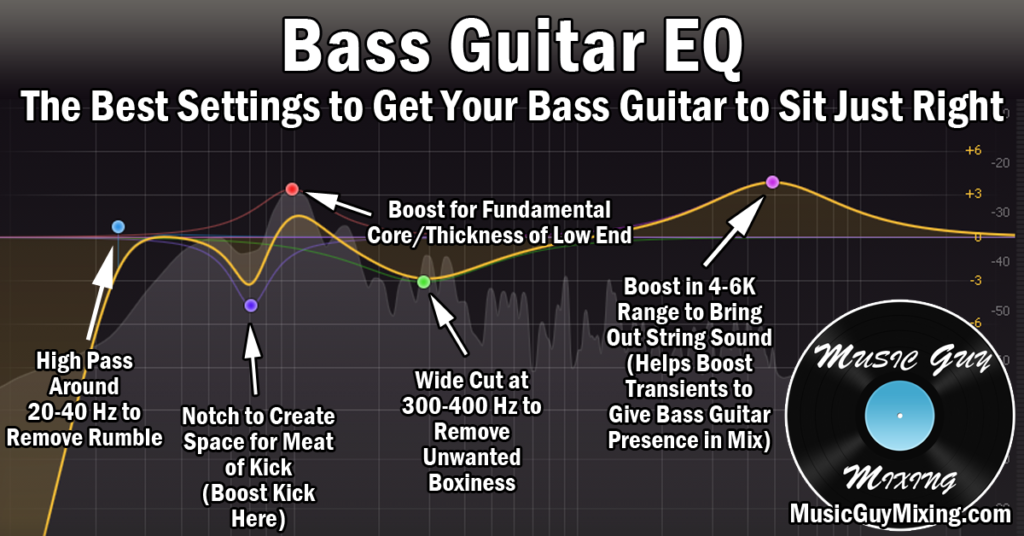The bass guitar’s fundamental frequencies are heavily concentrated within roughly 150Hz of one another. Knowing this can help you better EQ your bass guitar, so let’s take a look at this bass guitar frequency chart to better understand the important frequencies of our bass guitar.
Bass Guitar Frequency Chart

Below 40Hz
Short of drop tuning, which refers to tuning the open strings of the bass to lower frequencies than standard, there’s not much happening once you drop below 40Hz on the bass guitar.
You can use a high pass filter with a gentle slope somewhere between 20 and 40 Hz to gently roll off the frequencies we can’t hear and which aren’t adding anything musical.
Fundamental Bass Frequencies (40-200)
An instrument’s “fundamental” range simply means where its more prominent frequencies exist.
Open E Frequency
A bass guitar’s open E resonates at 41Hz. Technically 41.2Hz, but we’ll round down for simplicity sake.
Thinking back to the four parts of a sound wave, this means the sound we hear when we pluck the open E string on a bass is resonating at 41 cycles a second.
As such, we don’t want to filter any higher than 40Hz at most. And again, if we’re in drop D tuning, that string will resonate at 36Hz, so we need to be even more conservative with a filter in that case.
Open A Frequency
A bass guitar’s open A resonates at 55Hz. Go up an octave, fretting the A string at the 12th fret, and we effectively double the frequency at 110Hz.
Open D Frequency
A bass guitar’s open D resonates at 73.42Hz.
Oftentimes between the A and D strings is RIGHT about where the kick drum’s fundamental frequencies lie. That thuddy and thick “meat” of the kick is usually right in that 60-80Hz range, so we need to be careful about getting our kick and bass working together, particularly when we want to pan them each right in the center (check out my audio panning guide).
You might think about sidechaining your bass to your kick with a compressor to get that bass to duck out and give the kick priority when it activates. You might even try sidechaining a dynamic EQ so that the fundamental of the kick gets pulled out of your bass only when the kick triggers. This keeps your bass intact better than using a static EQ cut on your bass to compliment the kick.
Open G Frequency
A bass guitar’s open G resonates at 98Hz.
I like to include one octave up on the G string, so roughly 196Hz, to encapsulate the practical fundamental range of the bass guitar.
In other words, the fundamental of the bass is roughly from 40Hz-200Hz.
300-600 (Low-Mid Overtones)
We start to get into some of the first overtones, meaning weaker higher frequency octaves of our fundamental frequencies.
There’s still a lot of character as we move on up the bass guitar frequency chart.
As I mentioned in the aforementioned bass guitar EQ guide, around 400Hz you might find some boxiness or even wonkiness here.

You can do a small cut here if you need more clarity on your bass.
600Hz-1500Hz (Grit/Bite Bass Guitar Frequencies)
The overtones as we approach 1k and beyond have some nice bite and grit to them.
We can develop this range to bring out more of that if your bass is sounding a bit flat, tonally speaking.
Try a boost here to rebalance your tone if you’re bass is lacking or disappearing.
1.5k-4k (Clarity Frequencies)
If you want more clarity from your bass, look no further than the 1.5-4k range.
Try a boost here, or if that’s not getting it done, add some harmonics via some high frequency focused saturation.
4k-10k (String Transients)
Right in the 6k area you start to really get into that percussiveness from the strings themselves.
Like the crack of mallet or stick on skin with your kick or snare, respectively, this percussiveness acts as the prominent frequencies for the transients of the bass.
If you’re finding that your bass is disappearing in the mix, try a boost in this range to help the metallic sound of the strings draw the listener’s attention and get that bass back up front.
Above 10k (Inaudible Frequencies)
Typically, barring some distortion or other harmonic effects, the bass tops off at the aforementioned string percussiveness. You can apply a gentle low pass filter at or above 10k to gently roll off unnecessary frequency information.
After you’ve gotten your bass guitar’s frequency spectrum sorted, make sure you know how to compress your bass guitar.

Pingback: How to Sidechain EQ From Bass to Kick - Music Guy Mixing